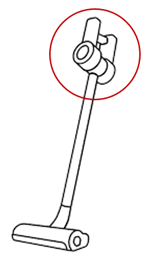Ergonomics Considerations for the Design of Cordless Stick Vacuum Handles

When choosing the appropriate vacuum across a wide array of available products, it is essential to consider operational features, such as amount of particle removal, ease of filter replacement, and battery life. However, usability and effort required must also be factored in. There are at least three vacuum design features that have ergonomics implications:
1. Weight Distribution – A vacuum design that concentrates its weight (from the battery, dust cup, etc.) closer to the handle will most likely make the vacuum feel lighter and be less fatiguing to use.
2. Handle Angle – Handles that are oriented so that the hand/wrist is mostly in a natural (or “neutral”) posture during vacuum use will also be more comfortable and result in less fatigue while vacuuming.

3. Handle Design – Users intuitively know that their hands are more protected with a “closed” vacuum handle (i.e., one that surrounds the knuckles), so there is less need to hold it tighter than is necessary. This design can also assist in vacuum maneuverability.  Compare this with an “open handle” design; here, the user must continually grip it to maintain control of the vacuum and may also grip it more tightly to prevent slippage. This increased effort can also be more fatiguing.
Compare this with an “open handle” design; here, the user must continually grip it to maintain control of the vacuum and may also grip it more tightly to prevent slippage. This increased effort can also be more fatiguing.
See also Ergonomics Study—Hotel Housekeeping
Dr. Allread is the Program Director of SRI-Ergonomics at The Ohio State University. In this position, Gary works extensively with companies and organizations nationwide, to provide a variety of ergonomics technical support services. This includes: conducting ergonomics worksite assessments and guiding improvement efforts; training employee groups about ergonomics principles; and developing and helping to manage companies’ ergonomics initiatives. A Certified Professional Ergonomist, he has lent his expertise to a wide range of industry sectors, including hospitality, healthcare, manufacturing, automotive assembly, transportation, warehousing, all with the mission to improve work practices, reduce injuries, and improve productivity among employees. Gary also coordinates Ohio State’s popular Ergonomics Short Course, offered bi-annually, in both on-site and remote formats.
As a professional who works in both industrial and academic settings, Dr. Allread works closely with Ohio State’s ergonomics faculty and staff to translate research to useable formats for the benefit of industry. He has been a member of the Human Factors and Ergonomics Society for 35 years and is currently President of the Applied Ergonomics Society (March 2022-March 2023.)




